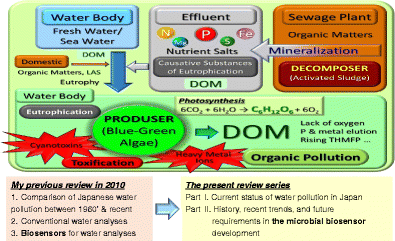Analytical and Bioanalytical Chemistry ( IF 4.3 ) Pub Date : 2018-05-08 , DOI: 10.1007/s00216-018-1080-0 Hideaki Nakamura
In Part I of the present review series, I presented the current state of the water environment by focusing on Japanese cases and discussed the need to further develop microbial biosensor technologies for the actual water environment. I comprehensively present trends after approximately 2010 in microbial biosensor development for the water environment. In the first section, after briefly summarizing historical studies, recent studies on microbial biosensor principles are introduced. In the second section, recent application studies for the water environment are also introduced. Finally, I conclude the present review series by describing the need to further develop microbial biosensor technologies.

Current water pollution indirectly occurs by anthropogenic eutrophication (Part I). Recent trends in microbial biosensor development for water environment are described in part II of the present review series.
中文翻译:

水环境的现状及其微生物生物传感器技术–第二部分:微生物生物传感器发展的最新趋势
在本综述系列的第一部分中,我通过关注日本案例介绍了水环境的现状,并讨论了针对实际水环境进一步开发微生物生物传感器技术的必要性。我全面介绍了大约2010年以后用于水环境的微生物生物传感器的发展趋势。在第一部分中,在简要总结了历史研究之后,介绍了有关微生物生物传感器原理的最新研究。在第二部分中,还介绍了对水环境的最新应用研究。最后,我通过描述进一步开发微生物生物传感器技术的必要性来结束本综述系列。

当前的水污染是由于人为富营养化而间接发生的(第一部分)。本综述系列的第二部分介绍了用于水环境的微生物生物传感器开发的最新趋势。


























 京公网安备 11010802027423号
京公网安备 11010802027423号